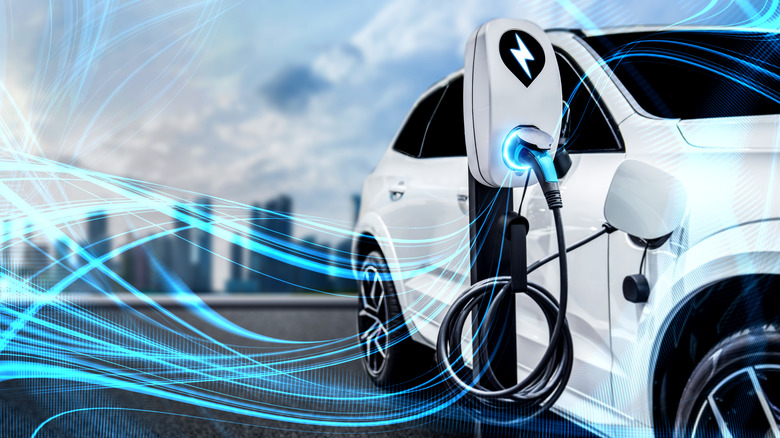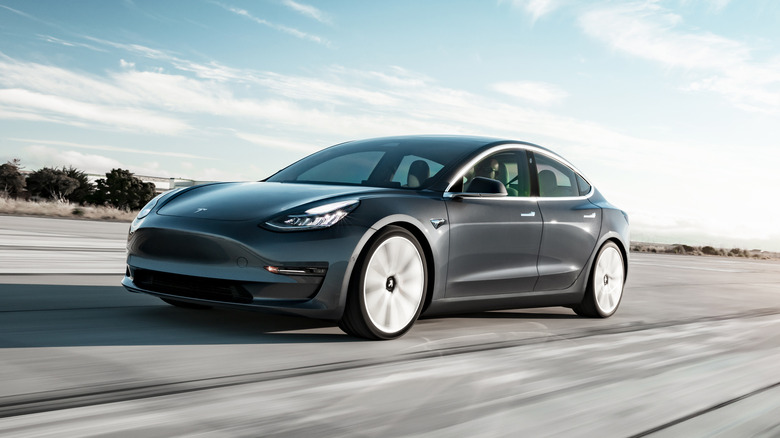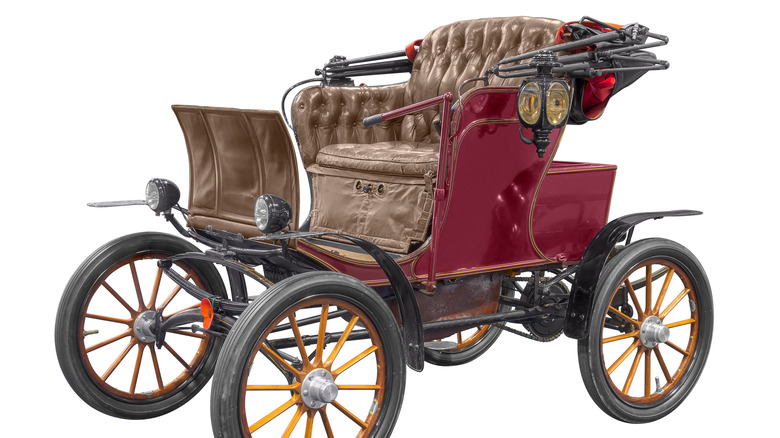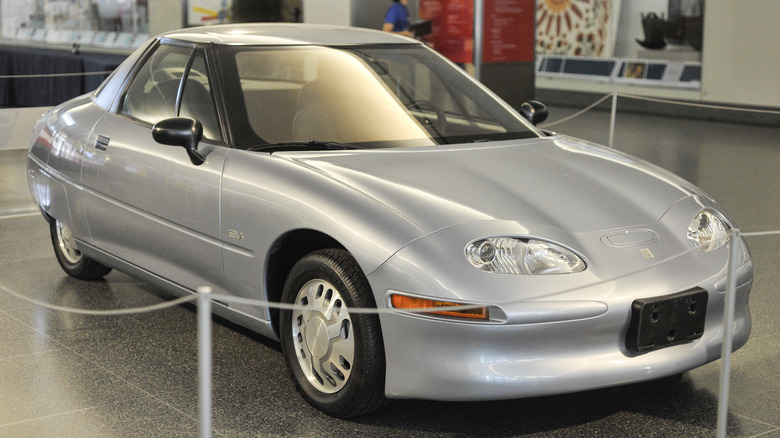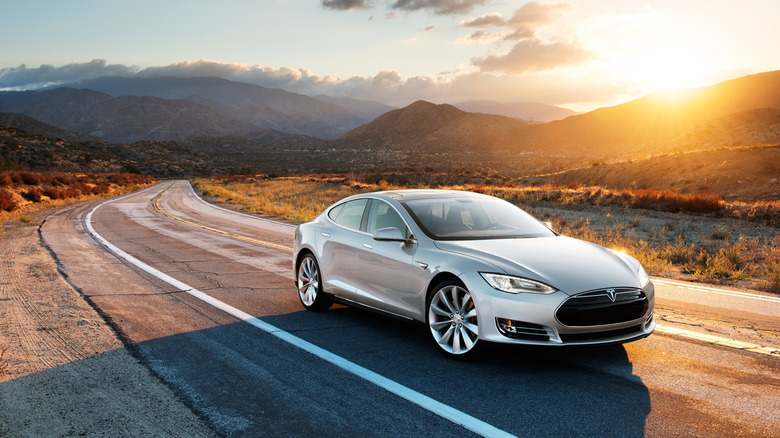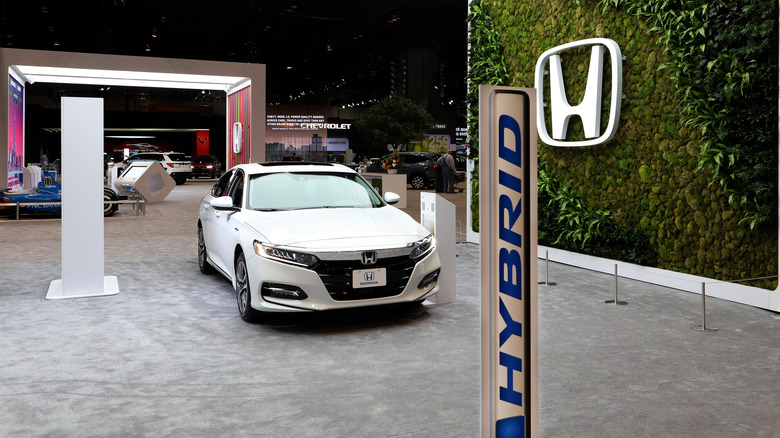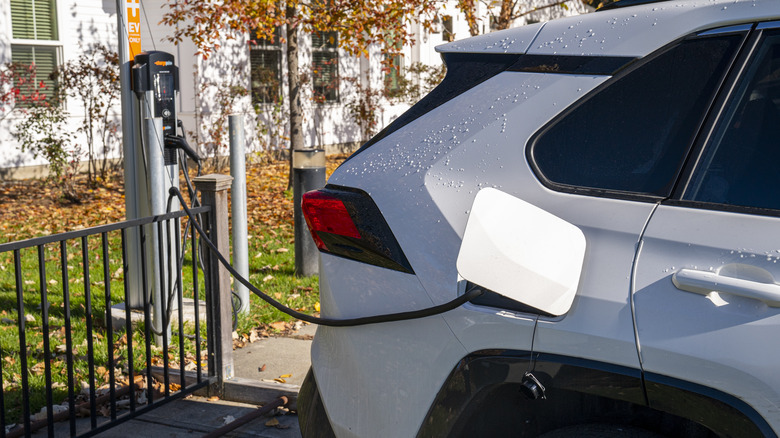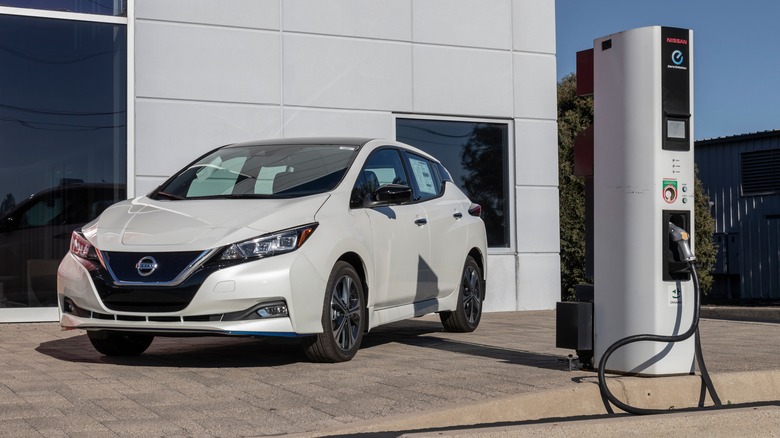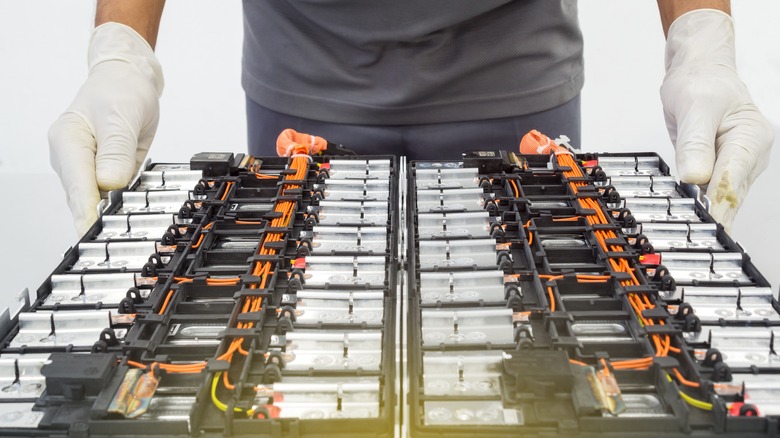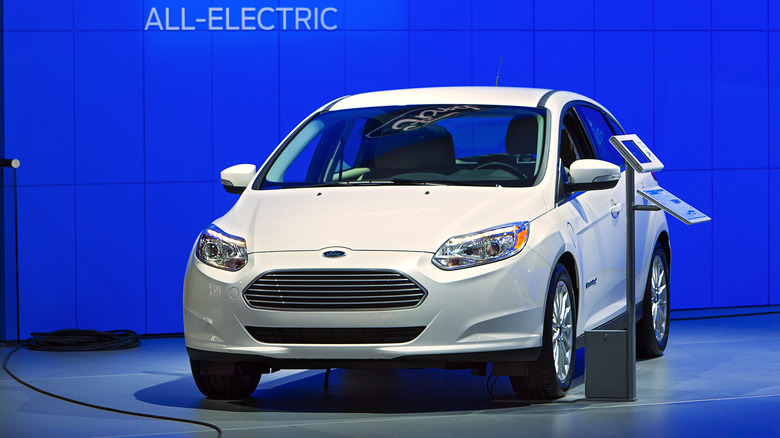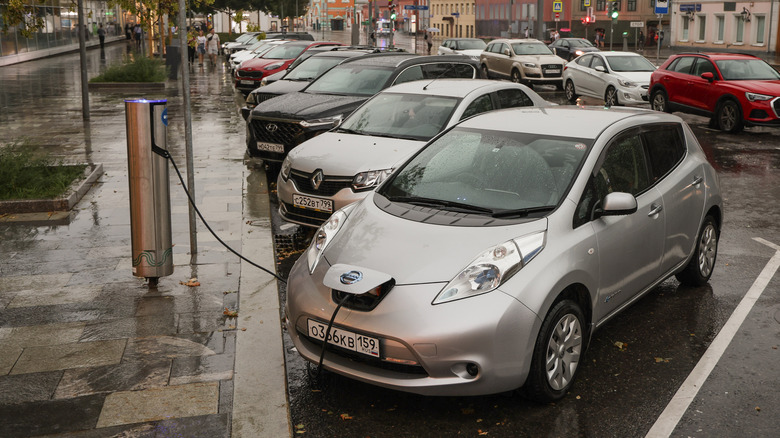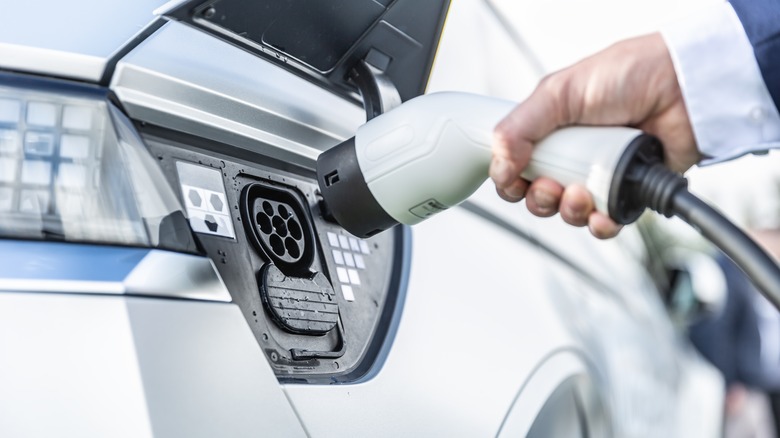Why Not All Electric Cars Are The Same
The past decade or so has seen a paradigm shift in the automotive world. At the start of the 2010s, electric cars were still a niche segment, one that primarily interested eco-conscious buyers looking for an alternative to mainstream gas-guzzling sedans and SUVs. Fast forward to 2021, and sales of electric cars hit 6.6 million units globally, more than tripling their market share from just two years prior. Brands that previously shunned the idea of electric power have had no choice but to develop their own EVs to keep up with the market. A few months ago, for example, British sports car maker Lotus announced its first electric crossover SUV, the Eletre.
The electric car is here to stay. But, assessing the "green" credentials of each kind of EV and even defining the term "electric vehicle" is not as straightforward as many people might think. With EV sales increasing at a record pace and some countries even aiming to ban new combustion-powered vehicles by the end of the decade, it's more important than ever that consumers are familiar with what an electric car actually is, and why not all of them are the same.
What is an electric car?
Despite being one of the most frequently used buzzwords across the industry, the term "electric vehicle" isn't quite as straightforward as it might initially seem. It's more of an umbrella term, covering a range of powertrains from mild hybrids to purely-electric BEVs (Battery Electric Vehicles). To complicate things even further, some markets don't use the term "electric vehicle" at all, with the world's largest car market, China, referring to them as New Energy Vehicles (or NEVs). The NEV term covers both hybrids and fully-electric vehicles, but in Western markets like the U.S. and Europe, a fully-electric car and a hybrid are generally understood to be two separate things.
Cars referred to as hybrids in the U.S. will have at least two means of propulsion, usually electric-gasoline or electric-diesel. In contrast, a car referred to as electric will usually only use electricity as a source of power. Each type of car has advantages, but current market data shows that Americans prefer pure-electric cars, which made up 73.1% of the overall electric car market in 2021.
The origin of electric cars
One of the biggest misconceptions about electric cars is that they're a recent breakthrough. Although the technology powering modern EVs is cutting-edge, the idea of an electric car actually goes back just as far as the combustion-powered automobile. The first primitive electric vehicles were developed in the late 1800s, and the first electric car available for customers in the U.S. went on sale in 1890. In 1899, the Baker Imperial Runabout debuted, which was a pioneering EV that was driven by the likes of Thomas Edison and then-First Lady of the United States, Helen Taft. Over the next decade, EVs grew massively in popularity, and by 1900, the U.S. Energy Department reports that around a third of the vehicles on American roads were electric.
This success didn't last for long, however, as the arrival of Henry Ford's mass-produced Model T in 1908 sealed the fate of this first wave of EVs. Ford's car was available for a price of $650 by 1912, the Department of Energy notes, whereas the average electric vehicle would cost $1,750. This led to a huge influx of sales for the Ford Motor Company, quickly stifling the demand for pricey EVs. Most electric car manufacturers simply couldn't bring prices down enough and went bankrupt in the decades that followed.
A few false starts
Throughout the middle part of the 20th Century, development of electric vehicles was abandoned altogether in favor of the combustion engine. Gas was cheap, the economy was improving, and a new generation of middle-class was emerging that wanted to cement their wealthy status with a shiny new Cadillac or Ford. Then, in the '70s, the oil crisis forced automakers to rethink their strategies. A new wave of electric cars emerged, although these were in many cases glorified golf carts that struggled to reach 40 mph and had severely limited ranges.
Needless to say, these electric minicars never really caught on, and as the '80s rolled around, gas prices stabilized, and EVs were again placed on the back burner. It took until 1996 for automakers to seriously revisit the idea, in response to a mandate by the state of California that manufacturers should sell a small portion of zero-emissions vehicles. A handful of EVs were produced in response to the mandate, including the GM EV1 and Toyota RAV4 EV. But, Car and Driver reported that intense lobbying from automakers caused the mandate to be scrapped, and with that, EVs fell back into obscurity for a few more years.
The modern era
By the late 2000s, the idea of the electric car had regained traction again, amid rising oil prices and concerns about the environmental impact of gasoline-powered cars. Hybrid vehicles were on the rise, spearheaded by the Toyota Prius, which despite its dull reputation, quickly gained a foothold in the market after its launch in 1997. In 2008, a little-known startup called Tesla would launch its first all-electric vehicle, the Roadster, signaling the beginning of what would become one of the greatest automotive industry success stories of the 21st Century.
Tesla's secret was that it succeeded in doing what few other automakers had managed: it made EVs cool. The hype around the launch of the Model S ensured that it sold well right out of the gate, and its success left traditional manufacturers scrambling to catch up. Over the following years, many of the world's biggest automakers would go on to launch their own ranges of EVs and hybrids, transforming what was once a widely-derided niche into one of the hottest trends in the global auto market.
Mild hybrids
With the current hype around the electric car market, it's important to differentiate between different types of electric cars, both hybrids and BEVs. Hybrids usually come in one of two forms, either mild hybrids or plug-in hybrids. Mild hybrids are in many ways the most similar to traditional gasoline cars, in that they use an internal-combustion motor as their primary source of power. This combustion motor is assisted by an auxiliary electric motor, which draws power from a built-in battery pack. The battery pack cannot be recharged independently, instead drawing energy from the gasoline engine and from other processes like regenerative braking.
The main advantage of a hybrid like this is increased efficiency, without any extra hassle. Because there's no way to independently recharge the battery, drivers don't need to worry about things like finding charging points or checking how much range is left. They simply refill the car with gasoline or diesel and proceed as they would normally. The downsides to mild hybrids usually center around their cost: With two motors and a more complicated powertrain, Edmunds reports that hybrids can be 20% more expensive to buy than their regular gasoline counterparts. Plus, their electric-only capabilities tend to be limited to urban, low-speed driving, if they have any all-electric capability at all.
Plug-in hybrids
The second main type of hybrid on sale is a plug-in hybrid (sometimes referred to as a PHEV). Like a mild hybrid, PHEVs use two motors, one electric and one gasoline or diesel. However, they also feature charging ports that can replenish the electric motor's battery independently. PHEVs can almost always run on all-electric power for a limited range, so short trips across town can be completed without ever turning the gasoline motor on. This means that drivers who typically complete short journeys can use the car in electric-only mode the majority of the time. But, they also have the flexibility of using the gasoline motor for occasional longer journeys.
This does mean, however, that buyers who want to take full advantage of their PHEV's electric capabilities will have to either have a fast-charging point installed at their home or, if they don't have the space, will have to make frequent trips to an electric charging station. Plus, it's worth noting that many PHEVs have very small all-electric ranges, with the Subaru Crosstrek Hybrid only achieving 20 miles of range, and even the class-leading Toyota RAV4 Prime only achieving 42 miles.
Battery EVs
The third and final major type of "electric car" is BEVs, or Battery Electric Vehicles. As its name suggests, these cars run entirely off electricity from battery packs. Many of the most well-known electric cars are BEVs, with Tesla's entire range, the Porsche Taycan, and the Nissan Leaf all falling into this category. Relying solely on batteries requires a much larger, heavier battery pack than a hybrid vehicle, but this extra weight is usually offset by the lack of a gasoline motor and the comparative simplicity of the drivetrain.
Anxiety about the range of a BEV has long been considered one of the key hindrances to their widespread adoption. But, in recent years, technology has improved, and the longest-range cars can now go over 300 miles on a single charge. Price is also often a sticking point, with a 2020 study showing that EVs cost 45% more to make than their gasoline counterparts, leading to higher prices for the consumer. However, that cost is decreasing over time, and a Bloomberg study suggests that, by 2027, BEVs will become cheaper to produce than gasoline cars. Battery EVs are, in theory, the greenest form of electric car, as they produce zero emissions from driving. That theory is not without its flaws, however.
The environmental problem with EVs
One of the current key issues with electric vehicles is that the manufacturing process for an EV currently creates a bigger carbon footprint than that of a combustion-powered vehicle, the Environmental Protection Agency notes. However, over the lifetime of the vehicle, studies cited by the EPA have shown that electric cars are on average less polluting in terms of greenhouse gasses. The issue is that most of these studies don't take into account the environmental impact of what happens with the car's batteries after they're no longer useful in the car. The automotive industry doesn't currently have a concrete plan for what to do with all these aging batteries, and the problem is expected to increase drastically in the next 10 years as more EVs reach the end of their working lives.
In an interview with The Guardian, a climate adviser at the World Economic Forum suggested that recycling all these batteries in an environmentally-friendly manner simply won't be feasible and that the best thing to do would be to try and keep the batteries in service for longer in alternative ways. According to The Guardian's report, a number of startups are trialing using old EV batteries to store power on wind and solar farms. But, it's hardly a perfect solution, given how many battery packs will be sent to scrap heaps in the coming decades. For now, there simply isn't a better solution to the problem.
The cost of battery technology
Another current issue with the technology behind electric cars is that battery packs are still prohibitively expensive to replace. The used car market is often overlooked in discussions about the future of EVs, but the reality is that batteries will eventually stop working, and used buyers are likely to be left holding the bag. In one recent case, a family who paid $11,000 for a 2014 electric Ford Focus were told it would cost $14,000 to replace the battery pack after it failed. They couldn't afford the fee, making the car effectively worthless after just six months of ownership.
Current federal law states that EV manufacturers must guarantee their battery packs for eight years or 100,000 miles, but since the Ford was a few months out of that guarantee period, there was nothing the family could do. The idea of needing to replace a gasoline engine in an eight-year-old car seems like terrible value, but as it stands, an eight-year-old EV's battery can fail at any time, and its owners will have little choice but to scrap it if they can't afford the battery replacement.
Diminishing returns
Battery packs breaking altogether is a serious issue, but an equally serious one is the rate at which certain batteries degrade. A 2018 study found that certain models of the Nissan Leaf had batteries that degraded over 9% of their total range each year. That would make them virtually useless after a decade or so, as their remaining range would barely be able to get drivers across a large city. Considering the average age of a car on American roads was 12.1 years old in 2021, that's a pretty poor showing from Nissan.
However, it's not all bad news, as batteries from other EV manufacturers have proven to be much more resilient, with Tesla's batteries reportedly losing just 10% of their range after 200,000 miles. Hopefully, as battery technology continues to improve, other manufacturers will be able to match, if not beat, Tesla's level of longevity. Plus, as electric charging infrastructure continues to expand across the U.S. and elsewhere, finding somewhere to recharge mid-journey should become less of a hassle.
Are EVs the future?
Even with the challenges that the electric car industry faces, it's clear that there are some considerable upsides to switching to electric power from internal combustion. As manufacturing processes are refined and the electricity grid increases its reliance on renewable energy, the environmental benefits of driving an electric car will only grow. For now, it's by no means a perfect green solution. But, considering how fast the technology is continuing to develop, there's no reason to think that many of the EV industry's current problems won't be solved within the next decade or so.
Whether pure battery-electric vehicles become the industry standard, or hybrids continue to prove a useful halfway house between new-age and traditional power, it's almost certain that electric cars will become more commonplace over the next few years. Although the U.S. hasn't announced any outright bans on combustion engines yet, the European Union has signaled that it plans to ban gasoline and diesel cars by 2035, and the UK has already pledged to ban them by the end of this decade. Electric cars might vary in their construction, range, and even their powertrains, but they all have one thing in common: they're not going away anytime soon.
